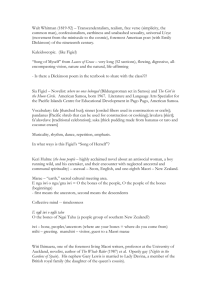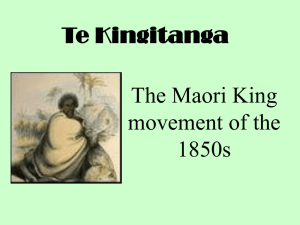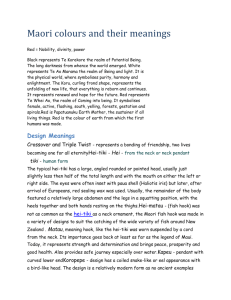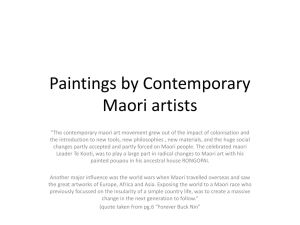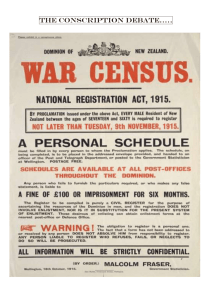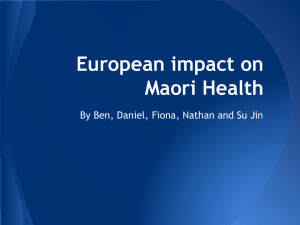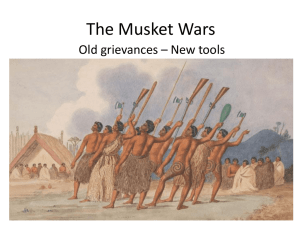Ki Te Whaiao- An Introduction to Maori Culture and
advertisement
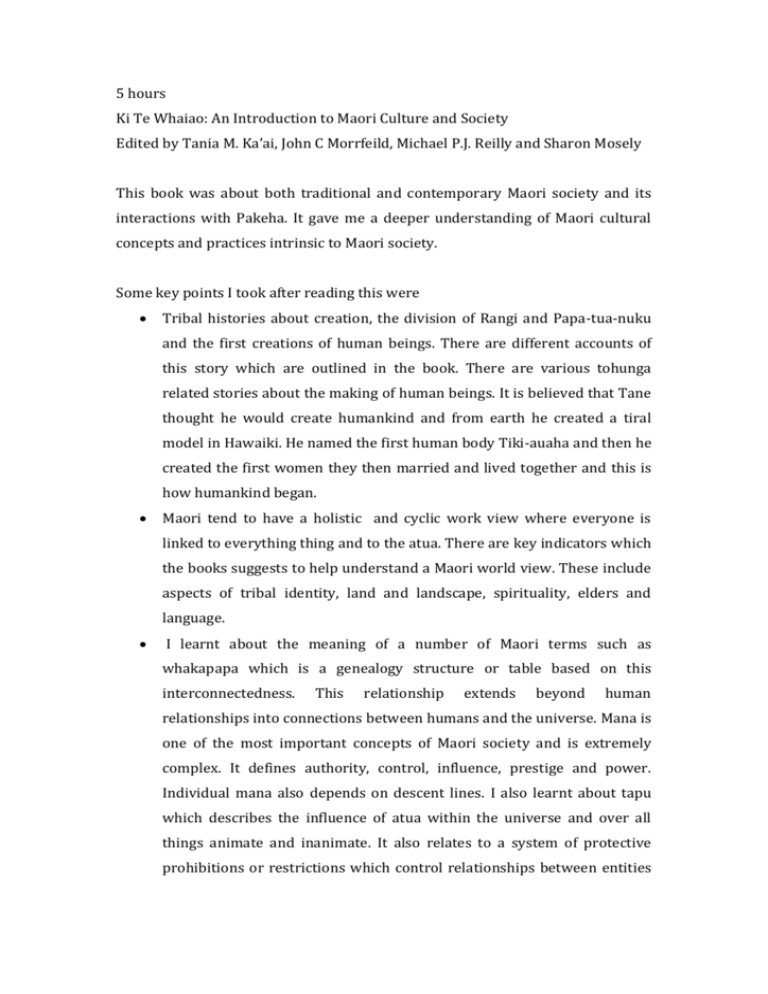
5 hours Ki Te Whaiao: An Introduction to Maori Culture and Society Edited by Tania M. Ka’ai, John C Morrfeild, Michael P.J. Reilly and Sharon Mosely This book was about both traditional and contemporary Maori society and its interactions with Pakeha. It gave me a deeper understanding of Maori cultural concepts and practices intrinsic to Maori society. Some key points I took after reading this were Tribal histories about creation, the division of Rangi and Papa-tua-nuku and the first creations of human beings. There are different accounts of this story which are outlined in the book. There are various tohunga related stories about the making of human beings. It is believed that Tane thought he would create humankind and from earth he created a tiral model in Hawaiki. He named the first human body Tiki-auaha and then he created the first women they then married and lived together and this is how humankind began. Maori tend to have a holistic and cyclic work view where everyone is linked to everything thing and to the atua. There are key indicators which the books suggests to help understand a Maori world view. These include aspects of tribal identity, land and landscape, spirituality, elders and language. I learnt about the meaning of a number of Maori terms such as whakapapa which is a genealogy structure or table based on this interconnectedness. This relationship extends beyond human relationships into connections between humans and the universe. Mana is one of the most important concepts of Maori society and is extremely complex. It defines authority, control, influence, prestige and power. Individual mana also depends on descent lines. I also learnt about tapu which describes the influence of atua within the universe and over all things animate and inanimate. It also relates to a system of protective prohibitions or restrictions which control relationships between entities and their expressions of tapu. These are some of the common Maori terms which I often hear but have not fully understood the meaning of them I learnt about community values which define Maori society and kin groups. Maori take care to establish their kinship ties both with the natural world and with other people. In classic Maori study whanau was part of a persons kinship group which lives immediately together, included the joint and extended family. Further from the daily life of a Maori was their iwi which translates as the bones of ones skin or tribe. Beyond this kin groups comes the waka as narratives of different kin groups begin stories around the actions of the tipuna who formed crews of the different waka. It also learnt that the birth order within classical Maori kin groups was of great importance as there is an important distinction between tuakana and teina. These various kinship terms overlap in their usages. This book goes into detail about powhiri rituals and encounters. Many traditional and important events happen on the Marae which traditionally belong to kinship groups. A powhiri is the ritual welcoming ceremony that occurs when visitors arrive on a marae. There are a number of processes that take place during this ceremony before the visitors are allowed to enter into the marae. I also read about death rituals and rights around tangihanga and a hui. Their ceremonies have developed over times with social changes, technology and Pakeha influence. The immediate family of the deceased have a role during this process which is to mourn and remain beside the tupapaku while the rest of the whanau organize and prepare the marae, do the karanga and prepare the food. Woemn wear pare kawakawa during the tangihanga which are wreaths of leaves worn around the head, they also wear black in contemporary Maori society which is an influence of Pakeha. A tangihanga usually lasts around three days although they can last longer. Maori encourage people to openly express their feelings during this time and not conceal emotions. The last night before the burial is a celebration of the life of the deceased. On the last day the coffin is closed and a church service is held on the marae before the body is carried to the burial ground. At the end of the tangihanga a church minister and the whanau pani go through the house of the deceased to dispel any spirits that may be dweling there and to allow the living to feel safe inside. I found it very interesting reading about these rituals as they have very different to any funeral I have experienced. After the burial everyone returns to the marae for a hakari. There is also a section of this book at that focuses on the arts. I found this very interesting as it discussed many things that I have been able to experience such as song, haka and musical instruments. The chapter explains waiata tnagi which are songs for those who have died, waiata aroha which are love songs, waiata whaiaipo, waiata tohutohu which are message bearing songs and oriori which are lullabies. It looks at the origins of haka and poi and the history behind these art forms and how Paheka influenced them. Poi was traditionally a male dominated sport which today it reflects women and their beauty It also looked into traditional Maori art forms such as carving, weaving and moko which I had a particular interest in art. I think that Maori arts are a good way to authentically incorporated te reo and tikanga Maori into the classroom if done effectively. Maori traditionally lived surrounded by their art as their houses were carved with the art of whakairo, their clothes tributes to raring and their bodies adorned with moko. Pakeha and colonization introduced new materials and tools and the decline of traditional art for a period of time. The next part of the book explores the Treaty of Waitangi and the understandings around the European concepts of terms and the varying understanding which are evident around sovereignty. The book suggests that the greatest challenge to understanding the Treaty in society today is the need to understand society around the time when the Treaty was signed to understanding what was motivating and guiding peoples actions. Many question why the Maori signed the Treaty and this book suggests that this may have been because they were anxious to assert their own authority and they many have also sought the protection of the Treaty. The Treaty was first drafted in English and then translated to Maori in a matter of hours which I was not aware of. The purpose of the Treaty was the cession of chiefly authority to Queen Victoria but William’s Maori translation did not make this clear which is where problems arise. Their were differences in the meanings of terms which has caused issues with individuals understandings and interpretations of the Treaty. There is also a section which looks at education and the status of the Maori language. The colonial education system limited the potential for Maori students and regarded them as only fit for physical or manual subject. The chapter notes that although there have been changes since the 70’s to make a bicultural education system for Maori there have only been tokenistic achievements based on assimilation. Maori question the outcomes of state education for their children and the tokenistic form of Maori culture inclusion. Today Maori parents want an education system that values Maori students and values their culture. The Maori language has declined as a means of communication due to colonization. In 1987 is became an official language and the Maori Language Comission was established. In the past 20 years there have been developments in te reo’s return to being an everyday language heard in different contexts such as Kura Kaupapa, language programmes, Maori operated radio stations, published books and music, and Maori studies departments in Universities.

